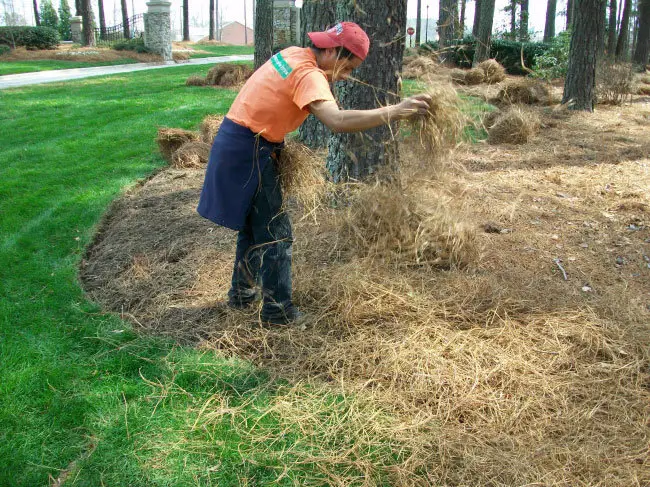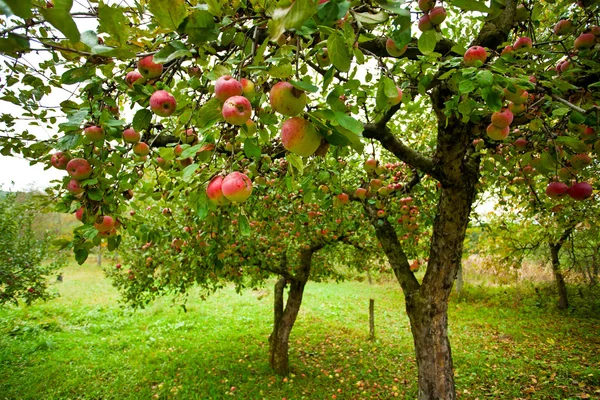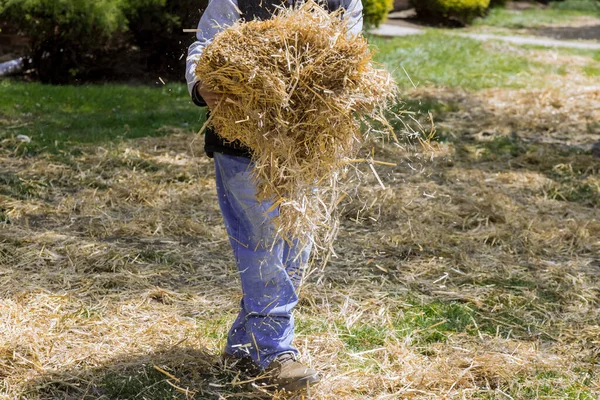When it comes to mulching, the choices can be overwhelming, with a myriad of materials available.
However, straw, with its rustic charm and abundant availability, has emerged as a common option for fruit tree mulching.
But is it a good mulch option?
Read on to uncover the secrets behind its effectiveness and potential impact on the health and productivity of your beloved fruit trees.
Is Straw Good Mulch for Fruit Trees?
Yes, straw can be an excellent choice for mulching fruit trees. When used properly, straw mulch can be an effective and beneficial mulch option.
5 Reasons Why Straw is a Good Mulch for Fruit Trees
1. Moisture Retention
Fruit trees require a consistent water supply to thrive, especially during dry periods.
Straw mulch plays a crucial role in retaining soil moisture by reducing evaporation.
The layer of straw acts as a protective barrier, slowing down the evaporation process and allowing the soil to retain water for a longer duration.
This is particularly beneficial in regions with limited rainfall or in areas prone to drought.
By maintaining adequate soil moisture levels, straw mulch ensures that fruit tree roots have access to a steady water supply, promoting healthy root development and overall tree growth.
Proper moisture retention also aids in nutrient uptake and supports various physiological processes within the tree.
2. Weed Suppression

Weeds can be a significant nuisance in fruit tree orchards, competing with fruit trees for essential resources such as nutrients, water, and sunlight.
Straw mulch provides an effective solution for weed suppression.
The dense layer of straw blocks sunlight from reaching weed seeds, preventing their germination and subsequent growth.
This reduces competition between weeds and fruit trees, ensuring that the trees receive the necessary resources for optimal growth and productivity.
By minimizing weed growth, straw mulch simplifies weed management efforts and reduces the need for frequent manual weeding or the use of herbicides.
Related: Is Cedar Mulch Good for Fruit Trees?
3. Temperature Regulation
Fruit trees are sensitive to temperature fluctuations, and extreme temperatures can adversely affect their growth and productivity.
Straw mulch acts as a natural insulator, regulating soil temperature around the roots of fruit trees.
In hot summer months, the straw layer helps to keep the soil cooler by providing shade and reducing heat absorption.
This protects the roots from heat stress and minimizes water loss through evaporation.
During colder periods, the straw mulch acts as a blanket, providing insulation and helping to keep the soil warmer.
This protects the roots from frost damage and ensures a more stable and conducive environment for root growth and overall tree health.
4. Erosion Prevention
Soil erosion can be detrimental to fruit trees, as it leads to the loss of topsoil and can expose delicate roots.
Straw mulch helps prevent erosion by reducing surface runoff and soil compaction.
When heavy rain or irrigation occurs, the layer of straw absorbs and disperses the water and prevents it from washing away the topsoil.
By protecting the soil from erosion, straw mulch helps maintain a stable soil structure, ensuring that the fruit tree roots remain well-supported and undisturbed.
This promotes healthy root development and provides a foundation for strong and resilient fruit trees.
5. Soil Enrichment
Organic matter is essential for soil fertility and the overall health of fruit trees. Straw mulch contributes to soil enrichment as it gradually decomposes over time.
As the straw breaks down, it releases organic compounds and nutrients into the soil. This improves its structure, fertility, and nutrient-holding capacity.
The decomposition process also encourages the activity of beneficial soil organisms, such as earthworms and microorganisms, which further enhance soil health.
The increased organic matter content resulting from straw mulch enrichment improves soil moisture retention, nutrient availability, and the overall nutrient cycling processes within the soil.
This creates a fertile and thriving environment for fruit trees, supporting their growth and productivity.
Related: Hemlock vs. Pine Mulch: Side-by-Side Comparison
Potential Drawback of Using Straw Mulch for Fruit Trees

While straw mulch offers numerous benefits, it’s important to consider one of its main potential drawbacks.
Mold and Fungal Growth
Straw mulch, especially when applied in thick layers or areas with high humidity, can create an environment conducive to mold or fungal growth.
To prevent this, ensure proper air circulation by avoiding excessive mulch thickness and regularly inspecting the mulch for signs of moisture-related issues.
Applying Straw Mulch to Fruit Trees
This requires careful attention to ensure its effectiveness and to avoid potential issues. Follow these steps to properly apply straw mulch.
Prepare the Area
Before applying straw mulch, ensure that the area around the fruit tree is clear of weeds and debris.
Remove any existing mulch or grass that may hinder the direct contact of the straw with the soil.
Determine the Mulch Thickness
For fruit trees, a recommended straw mulch thickness is around 2 to 4 inches (5 to 10 cm).
This thickness provides adequate coverage for weed suppression, moisture retention, and temperature regulation without suffocating the tree roots.
Related: Best Cedar Mulch for a Vegetable Garden
Create a Clear Space around the Trunk
Be careful to leave a clear space around the base of the tree trunk when applying the mulch.
Avoid piling the mulch directly against the trunk, as it can lead to moisture-related issues or encourage pests and diseases.
Leave a gap of a few inches between the mulch and the trunk to ensure proper airflow.

Apply Mulch in a Donut Shape
Apply the mulch in a donut shape around the base of the fruit tree to maximize its benefits.
Start by forming a circular area around the tree with a diameter slightly larger than the tree’s canopy.
Spread the mulch evenly within this area, making sure it extends beyond the drip line (outermost reach of the branches).
The mulch layer should be consistent in thickness throughout the designated area.
Check for Adequate Coverage
After applying the straw mulch, check for uniform coverage and ensure that the entire designated area is adequately covered.
The mulch layer should be thick enough to provide the desired benefits of moisture retention, weed suppression, temperature regulation, and erosion prevention.
Monitor Moisture Levels
Regularly monitor soil moisture levels beneath the straw mulch. While straw helps retain moisture, it’s important to strike a balance and avoid overwatering.
Stick a finger or a moisture probe into the soil to check for dampness.
Adjust your watering schedule accordingly, ensuring that the soil remains consistently moist but not waterlogged.
Periodically Inspect and Maintain
Regularly inspect the straw mulch for any signs of mold, fungal growth, or pest infestation. If necessary, remove and replace any affected straw to prevent further issues.
Periodically fluff and loosen the mulch to maintain proper airflow and prevent compaction.
Reapply as Needed
Over time, the mulch will break down and decompose. To maintain the desired benefits, replenish the layer annually or as needed.
Remove any excessively decomposed straws and add fresh ones to maintain the recommended thickness.
Related
- Best Gravels to Walk on Bare Feet
- 10 Best Mulch for Wet Areas
- Top 10 Wholesale Mulch Suppliers
- Top 7 Disadvantages of Decomposed Granite
- Gorilla Hair Mulch Pros and Cons
- Best Mulch for Perennials
- Grass Mulching Pros and Cons
- Hemlock vs Fir Mulch: A Comprehensive Comparison Guide
- Is Cedar Mulch Good for Fruit Trees? Yes, here’s why
- Oak Mulch Pros and Cons (Benefits & Drawbacks)
- Hemlock vs. Pine Mulch: Side-by-Side Comparison


